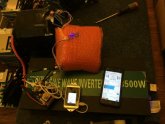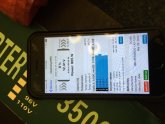My current plan is to create a 2p4s battery with the 280 ah cells from Xuba. Will this be a good use case for the @OverkillSolar BMS? I don't need the battery bank for high current draws. I camp in cold weather and need a battery set that will last all night running the furnace and still have enough juice to run the coffee maker in the morning.
You are using an out of date browser. It may not display this or other websites correctly.
You should upgrade or use an alternative browser.
You should upgrade or use an alternative browser.
Finally found a LiFePO4 BMS with Low-temp Charging Protection
- Thread starter Will Prowse
- Start date
Sgt Raven
Solar Addict
- Joined
- Feb 17, 2020
- Messages
- 1,079
What is the max amperage you think it will draw? I'm using a 120A with a 4S XUBA 280AH battery, but I haven't pulled out more than 10A at a time. I did try a 300W inverter I bought a couple of years ago, but never used and it blew up on the first try.My current plan is to create a 2p4s battery with the 280 ah cells from Xuba. Will this be a good use case for the @OverkillSolar BMS? I don't need the battery bank for high current draws. I camp in cold weather and need a battery set that will last all night running the furnace and still have enough juice to run the coffee maker in the morning.
What is the max amperage you think it will draw? I'm using a 120A with a 4S XUBA 280AH battery, but I haven't pulled out more than 10A at a time. I did try a 300W inverter I bought a couple of years ago, but never used and it blew up on the first try.
My spreadsheet says the max draw is 129 amps. But that would be turning on just about everything in my trailer at once, which is very unlikely. I included the four tank heaters in my calculation, but I rarely run them and most likely would only run the two on the 120 gallon fresh water tank if I had enough spare power. In a day, I calculated that the total draw would be 3302 watts and that is figuring an expected runtime for each item.
I have a 1000 watt MSW Xantrex inverter that is usually used only for the coffee pot. I didn't factor in the standby draw for that, just the known draw when it is active.
Sgt Raven
Solar Addict
- Joined
- Feb 17, 2020
- Messages
- 1,079
Max on your inverter looks like 145A, but that's a real short pull when it peaks. I think you might want to get Overkillsolar's 8AWG wire upgrade for the 120A version. That would give a little more fudge factor in it. IIRC, mdare pulled 147A on his 120A with the 8AWG upgrade he did. But that wasn't a long term test, either. Again, IIRC it was around post 400 or so in this thread.My spreadsheet says the max draw is 129 amps. But that would be turning on just about everything in my trailer at once, which is very unlikely. I included the four tank heaters in my calculation, but I rarely run them and most likely would only run the two on the 120 gallon fresh water tank if I had enough spare power. In a day, I calculated that the total draw would be 3302 watts and that is figuring an expected runtime for each item.
I have a 1000 watt MSW Xantrex inverter that is usually used only for the coffee pot. I didn't factor in the standby draw for that, just the known draw when it is active.
OverkillSolar
Solar Enthusiast
- Joined
- Mar 26, 2020
- Messages
- 188
A 150a surge is no problem for the BMS. Long term at that level heat builds up regardless of what size wires are on it.Max on your inverter looks like 145A, but that's a real short pull when it peaks. I think you might want to get Overkillsolar's 8AWG wire upgrade for the 120A version. That would give a little more fudge factor in it. IIRC, mdare pulled 147A on his 120A with the 8AWG upgrade he did. But that wasn't a long term test, either. Again, IIRC it was around post 400 or so in this thread.
NEWYORKHILLBILLY
New Member
- Joined
- May 12, 2020
- Messages
- 136
What would be the recommended long term draw of this BMS . I know its rated for 120 amps but many say to be conservative in that draw. what would you recommend?A 150a surge is no problem for the BMS. Long term at that level heat builds up regardless of what size wires are on it.
OverkillSolar
Solar Enthusiast
- Joined
- Mar 26, 2020
- Messages
- 188
I am comfortable with 120a at 100% duty cycle as long as it gets some air to stay cool.
The BMSs that I ran for extended load testing at 125 amps all got up to around 50 Celsius just sitting flat on the table. In a tight enclosure they got up to 90c and started melting the plastic box.
No need for a fan, just some free air for convection is enough.
The BMSs that I ran for extended load testing at 125 amps all got up to around 50 Celsius just sitting flat on the table. In a tight enclosure they got up to 90c and started melting the plastic box.
No need for a fan, just some free air for convection is enough.
Sgt Raven
Solar Addict
- Joined
- Feb 17, 2020
- Messages
- 1,079
I guess if the battery and BMS is in a closed box, a vent and a small computer case fan might be of some help. Really the fan part could be a pusher or puller, just as long as the air is exchanged enough.I am comfortable with 120a at 100% duty cycle as long as it gets some air to stay cool.
The BMSs that I ran for extended load testing at 125 amps all got up to around 50 Celsius just sitting flat on the table. In a tight enclosure they got up to 90c and started melting the plastic box.
No need for a fan, just some free air for convection is enough.
A method of air flow is in the works for my project. The location where the batteries will be placed is currently enclosed, but I plan to add a method of inflow and outflow. Supplementing the passive air flow with an active fan, based on temperature, is something I'll have in Phase II of the project.
Can the BMS sent a high temp signal to a relay? That would be an easy way to trigger the fan.
Can the BMS sent a high temp signal to a relay? That would be an easy way to trigger the fan.
NEWYORKHILLBILLY
New Member
- Joined
- May 12, 2020
- Messages
- 136
Did you do any testing at 1/2 duty cycle 60amps? I wondering if at 60 amps this would stay cool enough to be in a battery case with the cell'sI am comfortable with 120a at 100% duty cycle as long as it gets some air to stay cool.
The BMSs that I ran for extended load testing at 125 amps all got up to around 50 Celsius just sitting flat on the table. In a tight enclosure they got up to 90c and started melting the plastic box.
No need for a fan, just some free air for convection is enough.
OverkillSolar
Solar Enthusiast
- Joined
- Mar 26, 2020
- Messages
- 188
This is in the works. I’m reversing engineering the comm protocol so we can run arduino type stuff. A relay module will be no problem.A method of air flow is in the works for my project. The location where the batteries will be placed is currently enclosed, but I plan to add a method of inflow and outflow. Supplementing the passive air flow with an active fan, based on temperature, is something I'll have in Phase II of the project.
Can the BMS sent a high temp signal to a relay? That would be an easy way to trigger the fan.
I can do that today. I’ll wrap one up in bubble wrap and run it for a while.Did you do any testing at 1/2 duty cycle 60amps? I wondering if at 60 amps this would stay cool enough to be in a battery case with the cell's
OverkillSolar
Solar Enthusiast
- Joined
- Mar 26, 2020
- Messages
- 188
Sgt Raven
Solar Addict
- Joined
- Feb 17, 2020
- Messages
- 1,079
That could be a sticky mess and smelly, too.This is in the works. I’m reversing engineering the comm protocol so we can run arduino type stuff. A relay module will be no problem.
I can do that today. I’ll wrap one up in bubble wrap and run it for a while.
This is in the works. I’m reversing engineering the comm protocol so we can run arduino type stuff. A relay module will be no problem.
Blue Sky thought here: How about a low temp signal too? That way I could turn on a pad heater - or other suitable heater - to keep the batteries from getting too cold.
OverkillSolar
Solar Enthusiast
- Joined
- Mar 26, 2020
- Messages
- 188
Yea no problemBlue Sky thought here: How about a low temp signal too? That way I could turn on a pad heater - or other suitable heater - to keep the batteries from getting too cold.
OverkillSolar
Solar Enthusiast
- Joined
- Mar 26, 2020
- Messages
- 188
10 minutes in its only up to 35cThat could be a sticky mess and smelly, too.
...
20 minutes, 41c
Last edited:
OverkillSolar
Solar Enthusiast
- Joined
- Mar 26, 2020
- Messages
- 188
Sgt Raven
Solar Addict
- Joined
- Feb 17, 2020
- Messages
- 1,079
All i can say, Steve, is you go above and beyond for possible customers.@NEWYORKHILLBILLY it ran for 40 minutes at 70 amps and reached 48 Celsius, which is fine.
View attachment 13973
View attachment 13974
You are a credit to the DIY LFP world.
All i can say, Steve, is you go above and beyond for possible customers.
You are a credit to the DIY LFP world.
Agreed. I don't have my batteries yet, but I think I've settled on which BMS to go with. The BMS is inexpensive enough that I may buy what's available now and replace it when helpful new features are available.
As someone else on another thread lamented, picking solar panels and batteries are easy. Finding the right BMS is a lot more work. I would prefer a BMS with more amps, but for what I'm doing right now it's enough.
Similar threads
- Replies
- 4
- Views
- 311
- Replies
- 3
- Views
- 268
- Replies
- 0
- Views
- 230
- Replies
- 2
- Views
- 294





